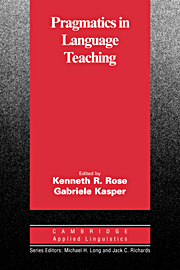Book contents
- Frontmatter
- Contents
- List of contributors
- Series editors' preface
- Preface
- Chapter 1 Pragmatics in language teaching
- I THEORETICAL AND EMPIRICAL BACKGROUND
- II ISSUES IN CLASSROOM-BASED LEARNING OF PRAGMATICS
- III THE EFFECTS OF INSTRUCTION IN PRAGMATICS
- Chapter 7 Acquiring French interactional norms through instruction
- Chapter 8 Inductive and deductive teaching of compliments and compliment responses
- Chapter 9 The role of input enhancement in developing pragmatic competence
- Chapter 10 Explicit and implicit teaching of pragmatic routines: Japanese sumimasen
- Chapter 11 Explicit instruction and JFL learner's use of interactional discourse markers
- IV THE ASSESSMENT OF PRAGMATIC ABILITY
- References
- Name index
- Subject index
Chapter 8 - Inductive and deductive teaching of compliments and compliment responses
Published online by Cambridge University Press: 05 October 2012
- Frontmatter
- Contents
- List of contributors
- Series editors' preface
- Preface
- Chapter 1 Pragmatics in language teaching
- I THEORETICAL AND EMPIRICAL BACKGROUND
- II ISSUES IN CLASSROOM-BASED LEARNING OF PRAGMATICS
- III THE EFFECTS OF INSTRUCTION IN PRAGMATICS
- Chapter 7 Acquiring French interactional norms through instruction
- Chapter 8 Inductive and deductive teaching of compliments and compliment responses
- Chapter 9 The role of input enhancement in developing pragmatic competence
- Chapter 10 Explicit and implicit teaching of pragmatic routines: Japanese sumimasen
- Chapter 11 Explicit instruction and JFL learner's use of interactional discourse markers
- IV THE ASSESSMENT OF PRAGMATIC ABILITY
- References
- Name index
- Subject index
Summary
Introduction
This chapter reports the results of a study on the effects of inductive and deductive approaches to instruction in pragmatics, with the target features being compliments and compliment responses. The literature on these speech acts – along with that on requests and apologies – is among the richest in crosscultural and interlanguage pragmatics, offering coverage of both pragmalinguistics and sociopragmatics. Compliments and compliment responses were also among the first speech acts to be targeted for empirically informed teaching of pragmatics (Holmes & Brown, 1987), as well as for the study of the effects of instruction in interlanguage pragmatics (Billmyer, 1990a, 1990b). The current study incorporates aspects of each of these lines of inquiry, but adds several elements, namely, the two instructional approaches and the foreign language context.
Background
We will not provide a detailed survey of the literature on the effects of instruction in pragmatics, or on issues such as explicit and implicit learning, both of which receive comprehensive coverage in Bardovi- Harlig (this volume) and Kasper (this volume). We will, however, discuss in brief some of the relevant literature on compliments and compliment responses, the effects of instruction in compliments and compliment responses, and inductive and deductive approaches to teaching.
Research on compliments is largely traced back to the work of Nessa Wolfson and Joan Manes (Wolfson & Manes, 1980; Manes & Wolfson, 1981; Wolfson, 1981a, 1981b, 1983, 1984, 1988, 1989a; Manes, 1983), which provided the first comprehensive description of the formulaicity of compliments in American English.
- Type
- Chapter
- Information
- Pragmatics in Language Teaching , pp. 145 - 170Publisher: Cambridge University PressPrint publication year: 2001
- 64
- Cited by



